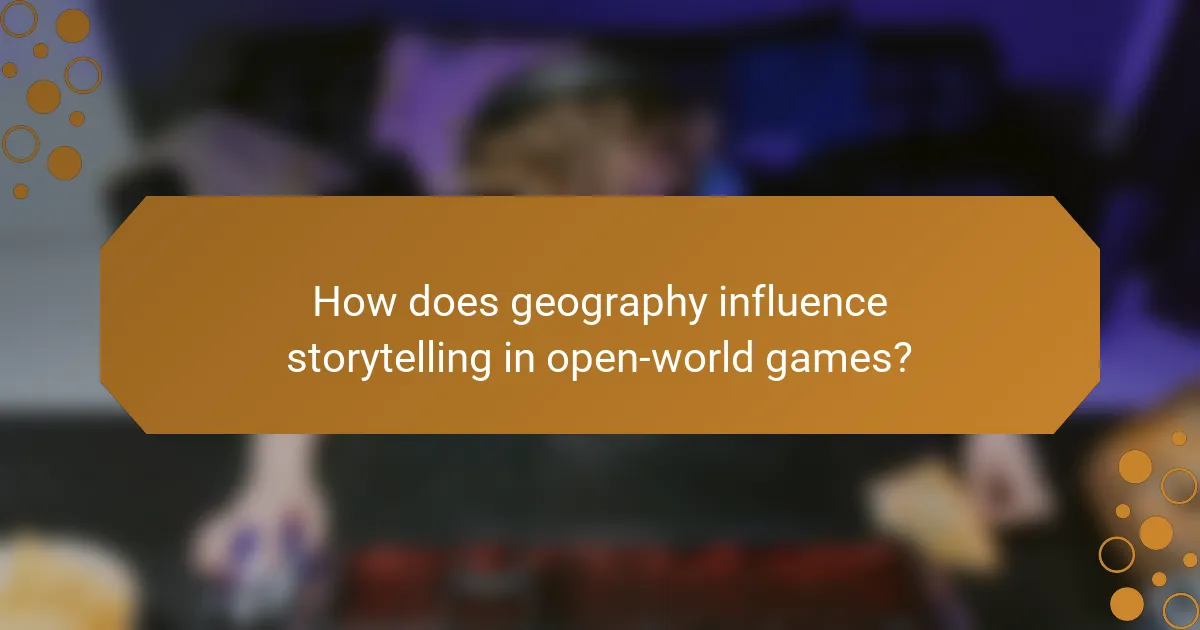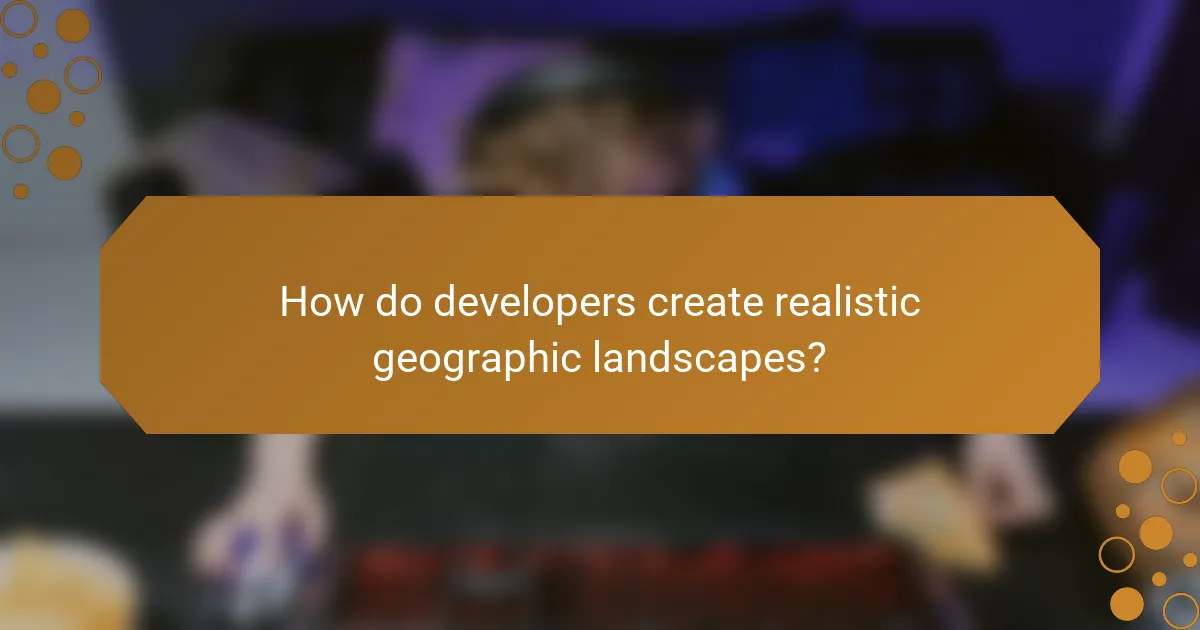Geography plays a crucial role in storytelling within open-world games, crafting immersive environments that enrich player experiences and deepen narrative engagement. The diverse landscapes and cultural elements not only shape the game world but also influence character interactions and player choices, making geography an integral part of the overall experience.

How does geography influence storytelling in open-world games?
Geography significantly shapes storytelling in open-world games by creating immersive settings that enhance player experiences and deepen narrative engagement. The landscapes, climates, and cultural elements of a game’s geography can influence plot development, character interactions, and player choices.
Immersive environments enhance player engagement
Immersive environments in open-world games draw players into the narrative by providing realistic and interactive settings. When players explore detailed landscapes, such as lush forests or sprawling cities, they feel a stronger connection to the story and characters. This connection can lead to increased emotional investment and a more memorable gaming experience.
For instance, games like “The Legend of Zelda: Breath of the Wild” use vast, open landscapes that encourage exploration, allowing players to uncover lore and secrets that enrich the narrative. The more players interact with their surroundings, the deeper their engagement with the story becomes.
Geographic diversity enriches narrative complexity
Geographic diversity in open-world games introduces various cultures, challenges, and storylines that enhance narrative complexity. Different regions can feature unique quests, characters, and conflicts that reflect their distinct environments and histories. This variety keeps the gameplay fresh and encourages players to explore every corner of the game world.
For example, in “Grand Theft Auto V,” players navigate through urban areas, rural landscapes, and coastal regions, each offering unique missions and interactions. This diversity not only broadens the gameplay experience but also allows for richer storytelling as players encounter different societal issues and character backgrounds.

What are the best open-world games that utilize geography effectively?
Some of the best open-world games that effectively utilize geography include titles that create immersive environments, enhance player experience, and deepen narrative engagement. These games leverage their landscapes to influence gameplay mechanics and storytelling, making geography a central element of the experience.
The Legend of Zelda: Breath of the Wild
The Legend of Zelda: Breath of the Wild is renowned for its expansive and diverse landscapes, from lush forests to arid deserts. The geography not only serves as a backdrop but also influences gameplay, encouraging exploration and interaction with the environment.
Players can climb mountains, glide from heights, and discover hidden shrines, all of which are seamlessly integrated into the world. The game’s physics engine allows for creative problem-solving, making the geography a vital part of the narrative and player experience.
Red Dead Redemption 2
Red Dead Redemption 2 features a meticulously crafted map that reflects the vastness of the American frontier. The geography plays a crucial role in shaping the game’s story, with different regions offering unique challenges and opportunities for players.
From snowy mountains to sprawling plains, each area is rich with detail and history, enhancing immersion. The dynamic weather and wildlife also interact with the geography, creating a living world that feels responsive and alive, further deepening the narrative depth.
Assassin’s Creed Valhalla
Assassin’s Creed Valhalla utilizes its geography to immerse players in the Viking Age, with a map that spans England and Norway. The varied landscapes not only provide aesthetic beauty but also influence gameplay, with different terrains affecting combat and exploration strategies.
Players can navigate through forests, rivers, and cities, each contributing to the overarching narrative of conquest and settlement. The geography is intricately tied to historical events, making it a key component of the storytelling experience.

How does player experience change with geographical elements?
Player experience in open-world games significantly shifts with the inclusion of geographical elements, as these features enhance immersion and interaction. Players often feel a stronger connection to the game world when they can explore diverse landscapes, which in turn influences their engagement and narrative experience.
Exploration fosters player agency
Geographical elements in games encourage players to explore their surroundings, leading to a greater sense of agency. When players navigate through varied terrains—such as mountains, forests, and urban environments—they make choices that affect their journey and the story’s progression.
This exploration can be structured or open-ended. For instance, games like “The Legend of Zelda: Breath of the Wild” allow players to approach objectives in multiple ways, enhancing their sense of freedom. Providing players with maps or markers can help guide them while still allowing for personal exploration.
Geography shapes emotional responses
The geographical design of a game can evoke specific emotional responses from players, influencing their overall experience. Different environments can create feelings of awe, danger, or nostalgia, depending on their design and context within the narrative.
For example, a desolate wasteland may evoke feelings of loneliness and despair, while a vibrant, lush landscape can inspire joy and wonder. Developers can use these emotional cues to deepen the narrative impact, ensuring that players feel connected to the story and its characters.

What are the key narrative techniques in open-world games?
Key narrative techniques in open-world games include environmental storytelling and dynamic quest systems, which enhance player immersion and engagement. These techniques create a rich narrative experience by allowing players to explore and interact with the game world in meaningful ways.
Environmental storytelling
Environmental storytelling involves using the game’s surroundings to convey narrative elements without explicit dialogue or text. Players can discover stories through visual cues, such as abandoned structures, scattered items, or unique landscapes that hint at past events. This technique encourages exploration and rewards players for paying attention to their environment.
For example, a ruined village might tell a story of a past conflict through its dilapidated buildings and remnants of daily life. Developers should consider how to integrate visual elements that resonate with the overarching narrative, ensuring that players can piece together stories organically as they navigate the world.
Dynamic quest systems
Dynamic quest systems allow players to engage with the narrative in a fluid manner, adapting quests based on player choices and actions. This approach creates a more personalized experience, as players can influence the story’s direction and outcomes. Such systems often include branching paths and multiple endings, enhancing replayability.
For instance, a player might choose to ally with different factions, leading to distinct quest lines and varying consequences. Developers should focus on creating meaningful choices that impact the game world, ensuring that players feel their decisions carry weight and contribute to their overall experience.

How do developers create realistic geographic landscapes?
Developers create realistic geographic landscapes by utilizing a combination of procedural generation techniques and real-world mapping strategies. These methods allow for the creation of immersive environments that enhance player experience and narrative depth in open-world games.
Procedural generation techniques
Procedural generation involves algorithms that create landscapes dynamically, allowing for vast and varied terrains without the need for manual design. This technique can produce realistic features such as mountains, rivers, and forests by using mathematical functions and noise algorithms.
Common approaches include Perlin noise and fractals, which help simulate natural randomness. Developers often balance detail and performance, ensuring that generated landscapes maintain visual fidelity while running smoothly on various hardware.
Real-world mapping and design
Real-world mapping incorporates geographic data from actual locations to create authentic environments. Developers may use satellite imagery and topographic maps to replicate the terrain, climate, and ecosystems of specific regions, enhancing the game’s realism.
When designing these landscapes, it’s crucial to consider scale and player navigation. For instance, a city modeled after a real-world location should maintain accurate distances and landmarks, allowing players to explore familiar settings while engaging with the narrative.

What role does player choice play in narrative depth?
Player choice significantly enhances narrative depth by allowing individuals to shape their experiences and outcomes within the game world. This interactivity fosters a sense of agency, making players feel more invested in the story and its characters.
Branching storylines based on location
Branching storylines often emerge from specific locations within open-world games, where players’ choices can lead to different narrative paths. For instance, a player might choose to ally with a faction in one region, unlocking unique quests and story arcs, while ignoring or opposing them in another area could lead to entirely different outcomes.
These location-based decisions can create a rich tapestry of interconnected stories, encouraging players to explore various environments to uncover all possible narratives. Games like “The Witcher 3” exemplify this, where each region offers distinct quests tied to its lore and inhabitants.
Consequences of exploration decisions
Exploration decisions carry significant consequences that can affect both the immediate gameplay and the overarching narrative. Choosing to explore a dangerous area may yield valuable resources or knowledge but could also lead to perilous encounters that impact the player’s journey.
For example, in “Skyrim,” players might discover hidden dungeons that offer powerful artifacts, but failing to prepare adequately can result in character death or loss of progress. Players should weigh the risks and rewards of exploration, considering how their choices will shape their experience and the game world around them.

How can geography enhance multiplayer experiences?
Geography can significantly enhance multiplayer experiences by creating immersive environments that encourage collaboration and strategic gameplay. Well-designed game worlds can foster social interactions and shared objectives, making the experience more engaging for players.
Shared spaces for collaboration
Shared spaces in multiplayer games allow players to interact and collaborate within a common environment. These areas can serve as hubs for teamwork, where players can strategize, trade resources, or plan their next moves together. Effective use of geography in these spaces can enhance communication and foster a sense of community.
For example, a central marketplace in an open-world game can facilitate player interactions, enabling them to exchange items and information. Additionally, geographical features like rivers or mountains can create natural boundaries that encourage players to work together to navigate challenges or conquer territories.
When designing shared spaces, consider the layout and accessibility. Ensure that key areas are easy to reach and encourage player engagement. Avoid overly complex designs that may confuse players or hinder collaboration. A well-structured environment can enhance the multiplayer experience and promote teamwork.



